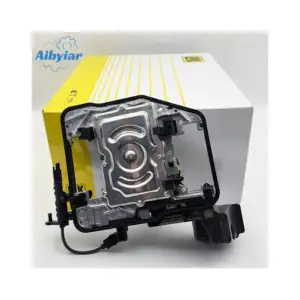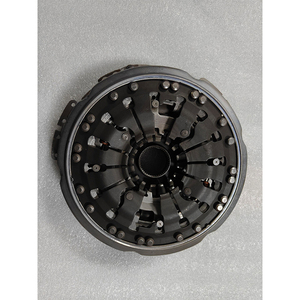(21965 products available)













































































































































 Ready to Ship
Ready to Ship




































































A transmission is essential for every vehicle, whether for casual driving or racing. It helps to transfer power from the engine to the wheels, enabling the car to move. The transmission also allows the driver to change the speed and torque of the vehicle. There are various types of transmissions, but the most popular are the manual and automatic transmissions. For VW enthusiasts, the transmission is a vital component that enhances driving experience and performance.
DSG Transmission VW
DSG (Direct Shift Gearbox) transmission is a dual-clutch automatic transmission popularized by Volkswagen. The DSG transmission uses two clutches to pre-select gears, enabling smooth and rapid gear shifts. This transmission provides better acceleration and fuel efficiency compared to traditional automatic transmissions. VW DSG transmissions come in different versions, such as the 6-speed and 7-speed DSG. The 6-speed DSG transmission consists of two separate manual transmissions, each with a hydraulic clutch. One clutch controls gears 1, 2, and 3, while the second clutch controls gears 4, 5, and 6. The 7-speed DSG transmission has an additional set of clutches to accommodate more gears, making it suitable for high-performance vehicles.
Tiptronic Transmission VW
Another popular transmission in VW vehicles is the Tiptronic transmission. The Tiptronic transmission allows drivers to switch between automatic and manual shifting modes. While driving in automatic mode, the transmission analyzes driving habits and selects gears accordingly. In manual mode, the driver can manually shift gears using paddles or the gear lever. This feature gives VW drivers better control over the vehicle's performance and responsiveness. Tiptronic transmissions are available in 5-speed and 6-speed variants, with the 6-speed model offering smoother shifts and better performance.
4Motion Transmission VW
4Motion is Volkswagen's brand name for its all-wheel-drive transmission system. This transmission system distributes power to all four wheels, enhancing traction and stability in various driving conditions. The 4Motion transmission is particularly beneficial for VW vehicles designed for off-road or high-performance applications. There are different types of 4Motion transmissions, such as the Haldex and Torsen-based systems. The Haldex system uses a multi-plate clutch to engage the rear wheels when needed actively. This allows for rear-wheel engagement when extra traction is required, such as on slippery or off-road surfaces. The Torsen-based 4Motion system uses a Torsen (torque-sensing) differential to distribute power between the front and rear wheels. This system offers real-time torque distribution and stability in challenging driving conditions.
Regular Transmission Fluid Changes
Maintenance of vw transmission is dependent on regular service of the transmission fluid. Schedule fluid changes at the intervals specified in the owner's manual. The fluid keeps internal parts lubricated and cool. Over time, the fluid breaks down and can no longer do its job. A professional service flushes out the old fluid and replaces it with fresh fluid. This protects the transmission from damage.
Regular Inspections
Have a qualified technician inspect the transmission system regularly. They check for external leaks, visible cracks, or damage to the transmission case. They also look at transmission controls like cables for wear. Internal components such as the torque converter, transmission bands, and clutches are also checked. Any issues are detected and fixed early before causing major problems.
Tire Rotation
Rotating the tires is important for even tire wear. This helps the transmission work correctly. Follow the schedule in the owner's manual for tire rotation. Typically, it's done every 5,000 to 10,000 miles or with every oil change. The tires are moved from one position to another. For example, the front tires go to the rear, and vice versa. This promotes even tread wear. An unbalanced car puts extra stress on the transmission over time.
Monitor Transmission Temperature
Heat is the enemy of transmission longevity. VW vehicles have a transmission temperature gauge or warning light. Drivers who tow heavy loads or drive in hilly areas should install an extra cooler to lower temps. Overheating can cause serious damage that is costly to repair.
Use Recommended Parts
Only use transmission fluids, filters, and other components that meet VW specifications. Low-quality aftermarket parts could cause issues down the line. VW-approved parts provide reliable performance and durability.
Warming Up in Cold Weather
In colder months, allow the vehicle to idle for a few minutes before driving. This lets the transmission fluid circulate. Driving right away in cold weather puts excess strain on the transmission components.
Don't Overload
Avoid exceeding the vehicle's towing or payload capacity. Carrying too much weight places additional stress on the transmission over time. This can lead to overheating and premature failure.
Proper Shifting
Automatic transmission drivers should always use the gear selector as instructed. From Park to Drive, wait for the car to fully stop. Avoid Manual transmission slipping the clutch or riding it. Learn the proper shifting techniques in the owner's manual.
When choosing a transmission vw, here are some things to consider.
Understand transmission types
The VW brand offers a wide range of vehicles, and each vehicle is equipped with a different transmission type. The transmission type may be manual transmission, automatic transmission, or dual-clutch transmission. In a manual transmission, the driver has to manually select and change the gears using a clutch pedal and gear lever. In automatic transmission, the vehicle does all the gear selection and gear changing work without any human interruption. In dual-clutch transmission, two clubs are used, one for gear selection and the other for gear shifting, which results in faster shifting of gears. Consider the type of transmission each VW vehicle model has and choose the one that fits business needs.
Consider vehicle usage
Consider the purpose the vehicle will be used for. If the vehicle is for carrying goods and products from one place to another, a transmission system that allows smooth and efficient gear change at different speeds is ideal. For public transportation, choose a vehicle with a transmission system that offers a comfortable ride.
Consider maintenance and reliability
Research and find out the transmission systems that require little maintenance and those that are more reliable. Generally, manual transmissions require more maintenance and offer less reliability compared to other transmission systems. Automatic transmissions are more reliable and require minimal maintenance.
Test drive
It is always a good idea to take the vehicle equipped with the desired transmission system for a test drive. During the test drive, pay attention to how the transmission feels, its response, and its overall performance.
Consult with experts
If confused about choosing the right transmission system for a specific need, consult with automotive experts. The expert can provide in-depth knowledge about different transmission systems and help choose the right vehicle.
Some transmission repairs require specialized tools and knowledge, making them better suited for professional mechanics. However, there are a few simple maintenance tasks that VW owners can perform themselves. Before attempting any transmission work, consult the owner's manual and warranty information. Here are some steps to guide in DIY and replace transmission:
Identify the issue:
Check the transmission fluid level and condition. Look for leaks under the vehicle. Take note of any unusual noises or behavior from the transmission.
Gather necessary tools and materials:
Owner's manual, VW repair manual, basic hand tools, transmission jack (for major repairs), torque wrench (for reassembly), new transmission fluid (if changing), and transmission filter kit (if replacing).
Follow safety precautions:
Use jack stands when working under the vehicle. Wear safety glasses and gloves. Be aware of sharp edges and hot components.
Follow repair manual procedures:
For major transmission repairs or replacements, consult the VW repair manual for disassembly and reassembly steps. Ensure the new transmission is properly aligned and mounted to the engine and vehicle frame.
Dispose of old transmission fluid and components:
Take old fluid and parts to a recycling center. Follow local regulations for hazardous materials.
Q1: How long does a Volkswagen transmission last?
A1: There is no specific timeframe for when a Volkswagen transmission will fail. However, the transmission is designed to last as long as possible. It can last up to 7 years or 150,000 miles with proper maintenance. The longevity of the transmission depends on various factors, such as driving habits and road conditions.
Q2: What are the signs of a failing transmission?
A2: The transmission fluid might leak under the vehicle. It is also hard to change gears, and the car shakes or slips when accelerating. Other signs include strange noises, a burning smell, and the check engine light being on.
Q3: What causes transmission problems?
A3: Transmission problems are mostly caused by neglect. Not changing the transmission fluid on time can cause wear and tear, leading to problems. Other causes include overloading the vehicle, internal component failure, and manufacturing defects.